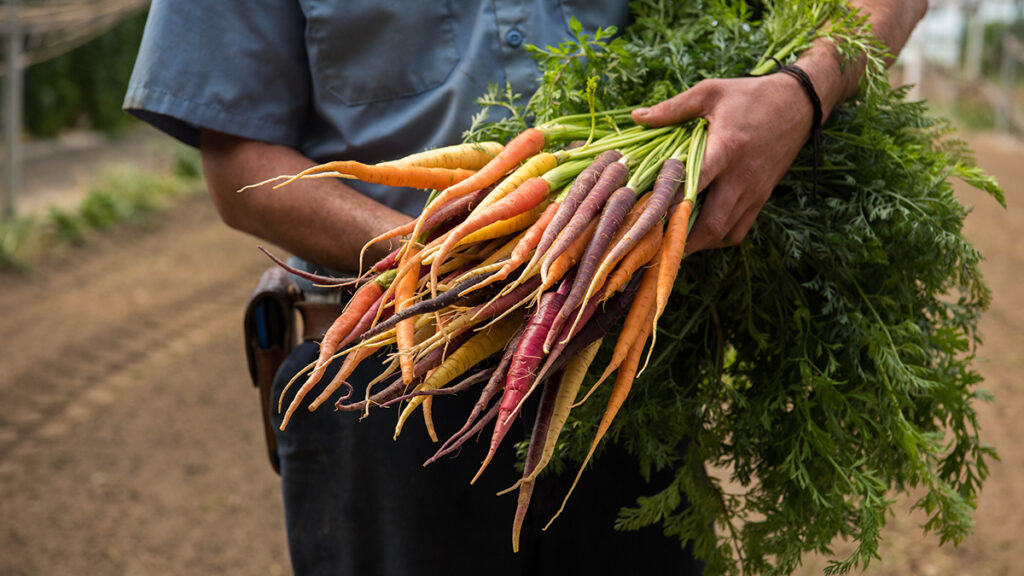For Farmer Lee Jones, certain vegetables have such incredible flavors, colors, and health benefits that the only word to describe them is "magical." And this season, the "magic" word is carrots.
"People assume that a carrot is a carrot is a carrot...not true!" he exclaims. "At The Chef's Garden, we grow white, yellow, peachy pink, purple, and orange — a rainbow of carrots!"
And a rainbow of flavors and textures too. From sweet and nutty to earthy and herbal, these crunchy, juicy, sweet carrots are grown as traditional long carrots and even turnip-shaped round ones.

"The variety of the carrot selection we offer is important," Farmer Lee says. "But, most important, is how they're grown and the regenerative farming techniques used to rebuild the soil." Indeed, that is where the real "magic" happens.
In his fields in Huron, Ohio, Farmer Jones relies on a refractometer — a tool that looks like a 5-inch-long telescope and measures the level of natural sugar in fruits and vegetables in a unit of measurement called brix. One gram of sugar per 100 grams of juice is one brix unit. "Our carrots measure between 12 and 16 brix per unit versus three brix for grocery store carrots labeled as "baby carrots," which are larger carrots shaved down and machine shaped."
Machine shaped? Blasphemy.
Those natural sugars are better than adding granulated sugar to our diets. "And all that natural sweet flavor, along with beauty and variety, means we can get kids — and us — to eat and like carrots," he says.
What makes Chef's Garden carrots special?
Carrots are full of fiber and nutrients, including vitamin K1 for bone health. They are also loaded with the antioxidant beta-carotene, a pigment found in plant foods that gives them their color and whose name is derived from the Latin word for carrot: carota. Our bodies convert beta-carotene to vitamin A, which supports eye health and boosts immunity.
Chef's Garden carrots provide more nutrition than commercially grown carrots since the soil in which they're grown is continually and naturally replenished. Strong, healthy Chef's Garden carrots can fend off weeds and insects without harmful pesticides and other chemicals. "For some of our vegetables, you're getting 50% more nutrition than store-bought commercial vegetables," Farmer Lee says.
How to use carrots
"People love to use carrots to make ribbons," Farmer Lee says. To make carrot ribbons, use a vegetable peeler to run the blade down the entire length of the vegetable to create thin, delectable, tender strips. This creates a delicate, tender texture, and you can quickly sauté the carrots in olive oil for a side dish or add them to pasta primavera. You can also do this with zucchini and yellow squash.
Farmer Lee recommends adding carrot ribbons to add to a salad with a mesclun mix.
Roast whole carrots with other seasonal vegetables harvested at the season's peak, such as beets, radishes, turnips, and broccoli, and serve them with yogurt dip for an enticing way to kick off a get-together. And for a healthy sweet treat, shred carrots and bake them into savory muffins or juice them for a refreshing smoothie.
"Carrots are a root-to-tip vegetable, so don't discard those tops," Farmer Lee adds. Chop them and add to a salad, or swap them for basil and make a delicious, earthy carrot pesto.
Our favorite carrot recipes
How to care for and store carrots
Delicious, farm-fresh carrots are in season year-round. When buying carrots, look for firm, dry, and plump ones, and avoid any slimy or floppy carrots. Keep unpeeled and unwashed whole carrots submerged in water in the refrigerator to maintain their crispy, crunchy freshness for up to four weeks; cut carrots stored this way will last about two weeks. Grate or shred fresh carrots, freeze them later, and add to soups.
When it comes to storing carrots, Farmer Lee has a very important piece of advice: "Don't store carrots near apples," he warns. "Carrots absorb the apple's odors, produced by naturally occurring ethylene gas, which promotes deterioration and robs the carrots of moisture."
And we wouldn't want anything taking the magic out of our carrots.
.svg?q=70&width=384&auto=webp)






















